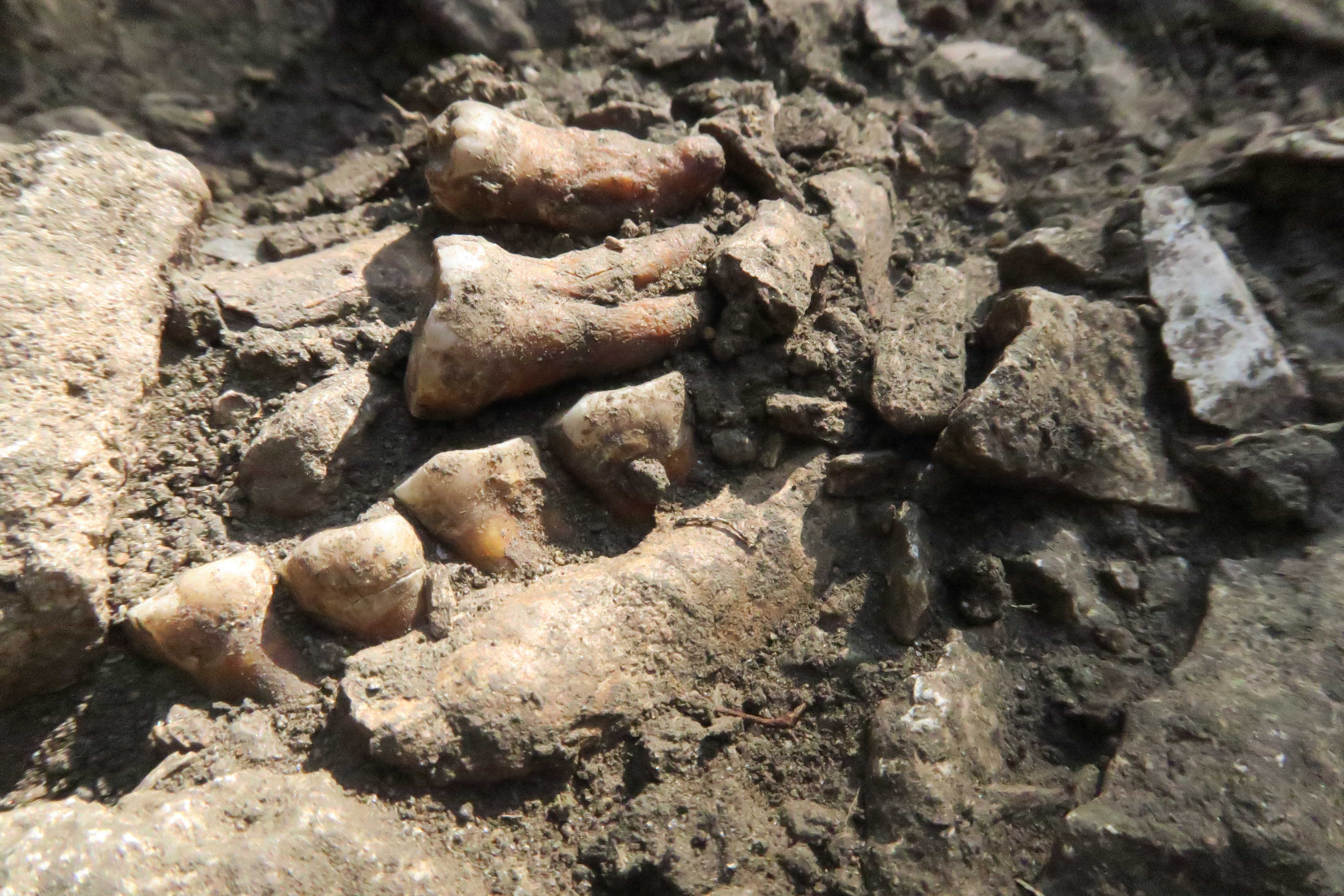Extinction
Italian Hiker Discovers Animal Tracks From a Time Before Dinosaurs, Hinting at a Prehistoric Ecosystem
Revealed by melting snow in the Alps, the imprints in rock were left by reptiles and amphibians during the Permian period, which ended with the world’s largest mass extinction
These Tiny Snails Are Breeding in the Wild for the First Time in 40 Years in French Polynesia
During a release of captive-bred snails in September, researchers discovered wild-born individuals from the Partula tohiveana species—which had been considered extinct in the wild—marking a huge milestone in a global effort to save them
A Cloned Ferret Has Given Birth for the First Time in History, Marking a Win for Her Endangered Species
Antonia, a cloned black-footed ferret at the Smithsonian's National Zoo and Conservation Biology Institute, has produced two healthy offspring that will help build genetic diversity in their recovering population
Scientists Reveal Rare 450-Million-Year-Old Arthropod Fossil Preserved in Glittering Fool’s Gold
The critter found in New York represents a new, extinct species of arthropod that could shed light on the evolution of today's insects, crustaceans and spiders
More Than One in Three Tree Species Around the Globe Are at Risk of Disappearing, New Report Finds
An assessment from the International Union for Conservation of Nature paints a grim picture of the extinction risk of the world's trees
A 110-Year-Old Pickled Thylacine Head Helped Build the Most Complete Ancient Genome to Date, Says 'De-Extinction' Company
Colossal Biosciences reports it extracted DNA and RNA from the Tasmanian tiger specimen, a key step forward in its effort to create a modern proxy of the extinct species. Other scientists are calling for data to back up the claim
These Are Americans' Biggest Fears in 2024, as the Country Is 'Becoming More Afraid'
Government corruption, loved ones becoming ill or dying, cyberterrorism and nuclear weapons topped the list of Chapman University's annual survey
A Massive, Mysterious 'Ghost' Fish, Feared Extinct for Nearly 20 Years, Has Been Rediscovered in Cambodia
The giant salmon carp was formally identified in 1991, and since then, fewer than 30 individuals had been documented
Admire the World's Largest Collection of Fossilized Poop at the New 'Poozeum' in Arizona
Owner George Frandsen has some 8,000 coprolites from dinosaurs, sharks and other creatures
Could Anyone Bring an Extinct Animal Back to Life? And More Questions From Our Readers
You’ve got questions. We’ve got experts
Ants Farmed Fungi in the Wake of Dinosaurs’ Demise 66 Million Years Ago
A new study from Smithsonian scientists analyzes ant and fungus species, and uncovers the origins of their close partnership
Divers in Mexico's Underwater Caves Get a Glimpse of Rarely Seen Artifacts, Fossils and Human Remains
Cenotes in the Yucatán Peninsula are time capsules preserving remnants of Maya culture and fossils of extinct megafauna
Extinct Volcanoes May Be an Untapped Source of Rare Metals
Unexplored iron-rich magma could help power current and future technologies
Rare and Elusive Australian Bird, Once Thought Extinct for 100 Years, Discovered by Indigenous Rangers and Scientists
Using sound recordings, the team identified the largest known population of the night parrot, a secretive species known as the "Holy Grail of birdwatching"
Rare Jaw Fossils Discovered in Texas Shed Light on a 20-Foot-Long Mosasaur
Unearthed last year, the remains could reveal new information on the extinct sea reptile, which crushed mollusks and shelled creatures with its large, round teeth
In Case Humans Go Extinct, This Memory Crystal Will Store Our Genome for Billions of Years
Scientists have created "a form of information immortality" meant to instruct future species on how to recreate humans. But who, or what, will find it?
Ancient DNA Reveals Neanderthal Group Was Isolated for 50,000 Years
A new study, based on the remains of a Neanderthal nicknamed Thorin, is shaking up what archaeologists long thought about these early humans in Europe
The Surprising Link Between Bats Dying and Human Infant Mortality
A new study finds that when bats in U.S. counties were decimated by the deadly white-nose syndrome, human deaths followed closely behind
Miners Unearth a Mummified Woolly Rhino in Siberia, With an Intact Horn and Soft Tissue
The rare discovery will help scientists find out more about the prehistoric animal’s development, diet and living conditions
20,000-Year-Old Columbian Mammoth Bones Discovered in Texas
While fishing at an undisclosed lake, Sabrina Solomon slipped and fell—and came face to face with the remains
Page 1 of 18
:focal(2250x1500:2251x1501)/https://tf-cmsv2-smithsonianmag-media.s3.amazonaws.com/filer_public/c4/75/c4752aad-0a2d-4431-a265-08627ac6c74f/3_1.jpg)
:focal(800x602:801x603)/https://tf-cmsv2-smithsonianmag-media.s3.amazonaws.com/filer_public/fa/a5/faa5479c-e74f-4f53-aae7-abe822511c67/born-in-the-wild-unmarked-partula-tohiveana-snail-observed-in-the-wild-meaning-the-species-is-re-established-c-paul-pearce-kelly-2.png)
:focal(576x347:577x348)/https://tf-cmsv2-smithsonianmag-media.s3.amazonaws.com/filer_public/a4/b9/a4b977bb-208f-483b-ba4f-92fa4ae1b899/usfws-antonias-kits-three-weeks-old-large.jpeg)
:focal(350x259:351x260)/https://tf-cmsv2-smithsonianmag-media.s3.amazonaws.com/filer_public/21/bc/21bc0afc-3f29-4463-adff-ff9ad861dacd/fossil-v1.jpg)
:focal(960x613:961x614)/https://tf-cmsv2-smithsonianmag-media.s3.amazonaws.com/filer_public/0d/71/0d7106f8-66f2-4c46-990b-242b9e1958d6/nature-6766114_1920.jpg)
:focal(191x115:192x116)/https://tf-cmsv2-smithsonianmag-media.s3.amazonaws.com/filer_public/4d/68/4d68d031-9cdf-425a-a66e-32d1834b07db/thylacinus_cynocephalus_2_gould.jpg)
:focal(1061x707:1062x708)/https://tf-cmsv2-smithsonianmag-media.s3.amazonaws.com/filer_public/d9/c2/d9c23b30-5da5-41e0-bbf4-b3133ed9ea48/gettyimages-82836845.jpg)
:focal(640x427:641x428)/https://tf-cmsv2-smithsonianmag-media.s3.amazonaws.com/filer_public/64/9f/649f75dd-2c83-428c-873a-51debc5a07c1/photo_2023-12-28_14-27-07.jpg)
:focal(1800x1800:1801x1801)/https://tf-cmsv2-smithsonianmag-media.s3.amazonaws.com/filer_public/d2/45/d245500b-55ff-4c77-bc45-5aa549ccc5ef/the_poozeum.jpg)
:focal(732x551:733x552)/https://tf-cmsv2-smithsonianmag-media.s3.amazonaws.com/filer_public/f5/61/f561cab7-4fb7-4041-a2c2-88d65608bfd0/ask.jpg)
:focal(1500x957:1501x958)/https://tf-cmsv2-smithsonianmag-media.s3.amazonaws.com/filer_public/2d/1b/2d1b50a7-3121-456f-9922-3ce10ed44ec9/a_-_ted_schultz_-_a_lower_agriculture.jpg)
:focal(1000x662:1001x663)/https://tf-cmsv2-smithsonianmag-media.s3.amazonaws.com/filer_public/59/44/5944fdd6-8215-4a86-854f-782ec0b2e58e/martin_broen_page22.jpg)
:focal(3583x2560:3584x2561)/https://tf-cmsv2-smithsonianmag-media.s3.amazonaws.com/filer_public/4f/70/4f70ffc0-086f-4b51-9748-10dd4c9ed1db/pexels-blaremc-9496447.jpg)
:focal(512x288:513x289)/https://tf-cmsv2-smithsonianmag-media.s3.amazonaws.com/filer_public/b2/73/b2730dfc-7061-4658-a36a-c7dffe1be220/bird.jpg)
:focal(425x320:426x321)/https://tf-cmsv2-smithsonianmag-media.s3.amazonaws.com/filer_public/21/4f/214fb752-d077-486e-a6b2-dca284c50163/globidens-alabamaensis.jpeg)
:focal(1024x575:1025x576)/https://tf-cmsv2-smithsonianmag-media.s3.amazonaws.com/filer_public/5a/e2/5ae236c1-dbe7-48a0-9b08-03e71a9e2590/skynews-genome-5d-crystal_6689808.jpg)

:focal(1752x1168:1753x1169)/https://tf-cmsv2-smithsonianmag-media.s3.amazonaws.com/filer_public/fa/a5/faa51fb1-20a7-4e91-b66e-fa6f07d81150/6950623578_064d5a166b_o.jpg)
:focal(500x333:501x334)/https://tf-cmsv2-smithsonianmag-media.s3.amazonaws.com/filer_public/d6/19/d6199f35-763b-47e4-a469-43488f0b271f/horn.jpeg)
:focal(2550x1676:2551x1677)/https://tf-cmsv2-smithsonianmag-media.s3.amazonaws.com/filer_public/b1/91/b1911093-3194-4c0d-81cb-a5b0a8a87ccf/gettyimages-1751778506.jpg)